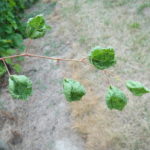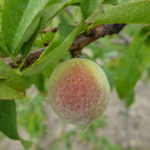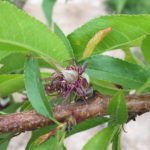Tree Fruit
The Office of the Indiana State Chemist has filed a Notice of Intent to Adopt a New Rule that will make most dicamba containing herbicides Restricted Use Products (RUP). This designation will allow the OISC to track sales of those herbicides. As many specialty crop growers know, dicamba is one of the growth regulator herbicides[Read More…]
Diagnosing Phytophthora crown rot is difficult. First examine the crown and rule out any type of mechanical damage, including rodent damage. Early symptoms of root and crown rot include delayed bud break, small leaves (often with leaf discoloration), and twig dieback. Bark discoloration, unthrifty growth, and premature leaf drop may occur later in the season[Read More…]
Wet weather continues to be a problem, not just for foliar disease, but root and crown rot, as well. Phytophthora root and crown rot is observed in wet spots: low-lying areas of orchards with heavy, poorly-drained soils. These pathogens can infect all fruit producing plants. Occurrence of this disease is sporadic and tied to wet[Read More…]
Although not always possible, avoid planting in low-lying, flood prone areas. Control weeds around the trunk of apple trees, as many serve as alternate hosts for the crown rot fungus(especially nightshades). Reduce nitrogen application on young trees, and trees with excessive growth as they are more susceptible to crown rot. As there are different species[Read More…]
Remember that many chemical thinners don’t work very well when daily temperatures are below about 65 F. So here we are with warm days ahead, which means rapid fruit growth, perhaps up to 1 mm per day. Apple fruit here in Lafayette are about 12mm which leaves us some good options for chemical thinning. However[Read More…]
Eastern Indiana Fruit Growers Association Hosting Orchard Garden tours at the “Slice of Paradise” 3912 S. Felton St., Marion, IN. Tuesday, May 23 at 6:30pm Dr. Rick Foster from Purdue University will be in attendance For more information, call 765-661-4597 Indiana Horticultural Society Field Day June 28, 2017 Tuttle Orchard Greenfield, IN More details to come but[Read More…]
Grapes have grown quickly this past week and most varieties are now past bud burst. The earliest have 4 to 6 inch shoots at this time. Blackberries and raspberries are also growing rapidly, with new primocanes emerging from the ground and laterals on floricanes out to 4 inches or longer. Flower buds are visible on[Read More…]
Upticks in powdery mildew last year, plus a mild winter (which allows the fungus to overwinter in buds) set the stage for powdery mildew (Fig.3). Early season rains kept things at bay, but the recent change to drier weather while leaves continue to grow sets the stage for this disease. Powdery mildew is active during[Read More…]





